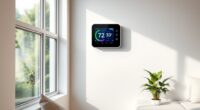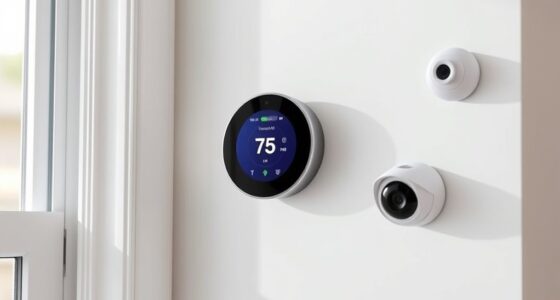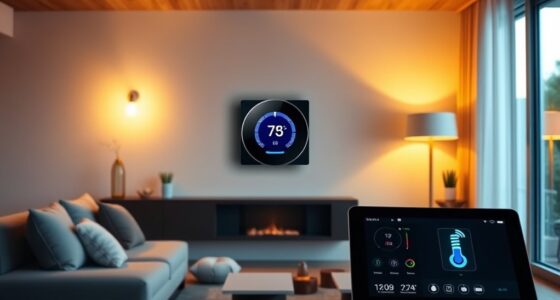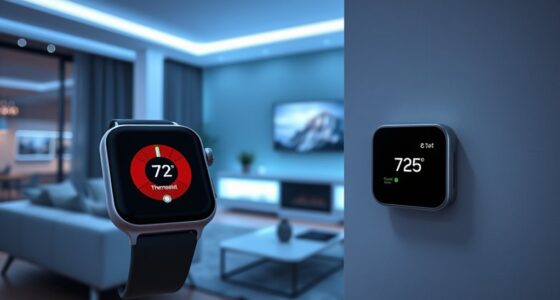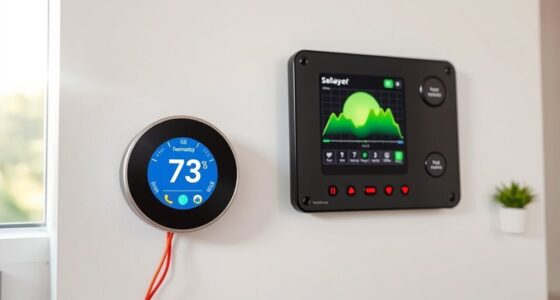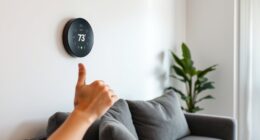By using your smart thermostat data, you can fine-tune your ceiling fan’s direction to maximize comfort and efficiency. During summer, set your fan to run counterclockwise to create a cooling breeze, while in winter, switch it to clockwise to push warm air downward. Monitoring temperature and occupancy patterns helps optimize fan settings automatically. Keep exploring how integrating these systems can lower energy bills and enhance your home’s comfort seamlessly.
Key Takeaways
- Analyze temperature trends and occupancy data from the smart thermostat to determine optimal ceiling fan direction for seasonality.
- Use real-time temperature insights to adjust fan rotation—counterclockwise for cooling, clockwise for heating—to enhance efficiency.
- Integrate occupancy detection with thermostat data to automatically turn fans on or off, conserving energy and maintaining comfort.
- Automate fan direction adjustments based on time of day or weather conditions, syncing with thermostat settings for proactive climate control.
- Monitor overall energy consumption patterns to fine-tune fan operation, ensuring alignment with heating and cooling system efficiencies.
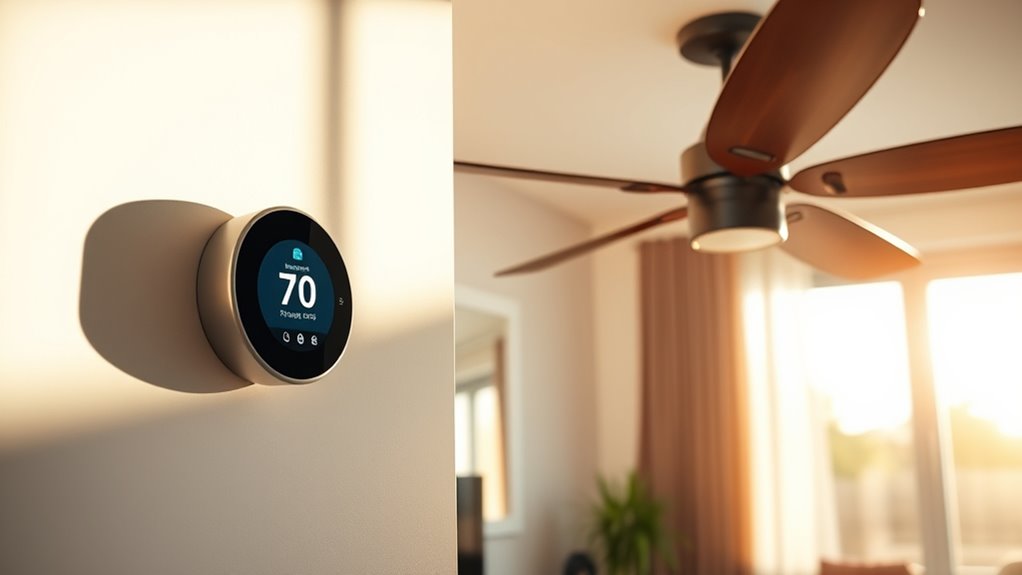
Smart thermostats are revolutionizing home comfort by providing data that can be used to enhance ceiling fan performance. When you integrate this technology into your home, you gain valuable insights into your heating and cooling patterns, which can be leveraged to improve user comfort and reduce energy consumption. By analyzing temperature trends and occupancy data, your smart thermostat can suggest the ideal fan direction and speed, ensuring you’re comfortable without wasting energy. This synergy between your thermostat and ceiling fans helps you create a more efficient environment, lowering utility bills while maintaining a cozy home.
Using smart thermostat data allows you to better understand when your home needs cooling or heating, so you can adjust fan settings accordingly. For instance, during hot summer afternoons, the thermostat might detect increased temperature levels and recommend directing the ceiling fan counterclockwise to create a cooling breeze. Conversely, in winter, the data could suggest switching the fan off or directing it clockwise to push warm air down and improve heating efficiency. These adjustments not only improve user comfort but also minimize unnecessary energy use, making your home smarter and more sustainable. Additionally, many smart thermostats incorporate energy-saving features, which further optimize fan operation based on real-time data.
Smart thermostat data guides fan adjustments, maximizing comfort and efficiency year-round.
Another advantage of utilizing smart thermostat data is the ability to customize fan operation based on occupancy. If your system detects that certain rooms are unoccupied, it can recommend turning off or adjusting the fans in those areas, conserving energy without sacrificing comfort in the spaces you use. This targeted control prevents energy waste and prolongs the lifespan of your ceiling fans. Over time, as your system learns your routines and preferences, it fine-tunes fan direction and speed automatically, ensuring comfortable levels and maximum energy savings.
Moreover, by syncing your ceiling fan controls with your smart thermostat, you can create automated routines that optimize airflow based on the time of day or weather conditions. For example, before you wake up or return home, your system can pre-adjust fan directions to ensure the environment feels just right when you arrive. This proactive approach enhances user comfort and reduces the need for manual adjustments, streamlining your home’s climate control. It also reinforces energy-efficient habits, since the system avoids unnecessary fan operation and adjusts in real-time based on real data.
In addition, understanding home energy consumption patterns through smart thermostat data can help you make informed decisions about when to operate ceiling fans most efficiently. By paying attention to these data-driven insights, you ensure your ceiling fans work in harmony with your heating and cooling system, delivering optimal performance tailored to your lifestyle.
Frequently Asked Questions
Can Smart Thermostats Control Multiple Ceiling Fans Simultaneously?
Smart thermostats generally don’t control multiple ceiling fans simultaneously through fan synchronization or multi fan control features. Instead, they manage your HVAC system’s temperature. However, some smart home systems and compatible smart switches or hubs can enable you to synchronize multiple fans, allowing you to control them together. You’ll need compatible devices and setup to achieve true multi fan control, ensuring your fans work in harmony for ideal comfort.
How Does Outside Weather Data Influence Fan Direction Adjustments?
You might wonder how outside weather data influences fan direction adjustments. When outdoor temperature and weather integration are taken into account, your smart system can optimize ceiling fan performance. For example, on hot days, it may direct fans to create a cooling breeze, while in cooler weather, it might adjust to circulate warm air. This ensures your home stays comfortable and energy-efficient, leveraging real-time outdoor conditions for smarter fan control.
Are There Specific Smart Thermostat Models Better for Fan Optimization?
Smart thermostat models stand out when it comes to seamless smart synergy. Look for thermostats with superior smart thermostat compatibility and sophisticated fan control features. These models prioritize precise programming, personalized preferences, and real-time responsiveness. Brands like Nest, Ecobee, and Honeywell often lead the pack, offering intuitive interfaces and adaptable functionalities. Choosing a thermostat with advanced fan control guarantees you optimize comfort, energy efficiency, and fan direction, making your space smarter and more comfortable.
What Safety Precautions Exist When Automating Fan Direction Changes?
When automating fan direction changes, you should prioritize electrical safety by ensuring all wiring is properly installed and grounded. User education is essential; you need to understand your system’s controls and limitations to prevent mishaps. Always follow manufacturer guidelines and consider consulting a professional if unsure. Regularly inspect your setup for damage or loose connections, and never override safety features, maintaining safe operation during automation.
How Often Should the System Update Fan Settings Based on Data?
Imagine your fan gently adjusting its blades like a dancer responding to a rhythm. You should update fan settings based on data accuracy, typically every few minutes or as often as your system refreshes. This update frequency guarantees the system stays responsive to temperature changes without overreacting. Regular updates make your home more comfortable and energy-efficient, so keep an eye on data quality to avoid unnecessary adjustments.
Conclusion
By harnessing smart thermostat data, you can fine-tune your ceiling fan’s direction like a skilled conductor guiding an orchestra. This synergy not only boosts comfort but also cuts energy costs, turning your home into a harmony of efficiency. Embrace this tech duet, and watch your living space breathe easier, cooler, and smarter—because when your fan and thermostat work together, they compose a symphony of comfort that hits all the right notes.

